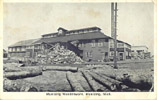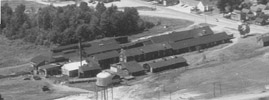
Munising Wood Products
Information and links related to the Munising Wood Products
factory that operated in Munising, Michigan from 1911 to 1955.

Interview: Elmer Carlson; June 3, 1975
The Munising Woodenware Company was started in 1908 (most other accounts say 1911 or 1912) in May by the following: Mr. Bonz, manager; Claude Pangborn, cashier and shipping clerk; Elmer Erickson, office manager; Fisher, mill foreman; President C.V.R. Townsend, of Negaunee, until he died at which time he was succeeded by John M. Bush. (Think he was also of Negaunee-comment by Faye Swanberg). Elmer said he was a great man. Square shooter, although a lot of people didn't like him. He had a special feel for investing. Took his money out of everything three days before the stock market crashed. Later in the bank here. (think First National-comment by Faye Swanberg). Also working at Woodenware were John Cavitch from Copemish as mill superintendent.
Machinery moved here from Copemish (Kalkaska.) Making bowls, butter moulds, round and square. Wood spoons; rolling pins; butter ladles, hardwood lumber and ties; sauerkraut forks. Told me they were happy if they made $1,000 a year. Paying help $0.35 an hour. Later wood tray 2 feet long, 8"-10" wide were made. Also fish planks used to bake whitefish or trout giving a special taste. Elmer Carlson started in 1918. In the office were Elmer Erickson, Henry Johnson, Carl Hinz, W. G. Lodholz, Elmer Carlson. Clothespin machines - 5 rounding and 5 saw slots. Al Frederickson, foreman. 12 packing by hand, two (sunny day) boxes, five - gross loose. The pins when finished upstairs dropped down in tumblers with paraffin wax chunks and rolled for hours until a wax polish was on the clothespins. To begin at the sawmill the boards were cut about 5' wide, 4' long 1/2 inch thick and dropped down to the lower floor and went into a planer and rounding machine and were cut off to the length of the pin and an elevator took them up to the top floor where they were rounded and cut a slot in the pin. In the latter years they made the spring clothes pins. The coil of wire was attached to the machine and it made the coil and the wood pin was cut on another machine and the spring automatically attached to the two clothespin pieces.
List of employees as compiled by Elmer Carlson
date of this list unknown
| Log yard | 3 | Woodenware Jack | 1 |
| Sawmill | 4 | Bowl mill turning | 2 |
| Bowl mill scaler | 1 | Office | 5 |
| Clothespin-round | 24 | Clothespin-spring | 4 |
| Dry kiln basic | 2 | Lumber yard | 2 |
| Engine room | 1 | Blacksmith shop | 1 |
| Machine shop | 1 | Millwright | 2 |
| Shipping dept. | 4 | Painting bowls | 11 |
| Sanding bowl | 5 | Steaming bowls | 1 |
| Foreman | 1 | Tractor driver | 1 |
| Scaler-log | 1 | Jackman-log yard | 1 |
| Lumber scaler | 1 | Electrician | 1 |
| Filer | 1 | Fireman | 3 |
| Pipe dept. | 1 | Clothespin machines | 5 |
| Total | 90 |
|---|
Closing date of the plant was July 1, 1955
Bill Wilson was 12 years old when he started at the Woodenware under special permit from school. John Cavitch was the superintendent.
Painting of bowls began when the Chicago outfit took over.
Butter boxes made were from 1/2# to 5# and were sold to stores to put their butter, lard, etc. in as they sold it to customers. Also veneer for chairs, and stiles for doors.

